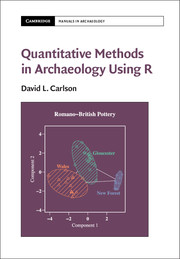18 - Assemblage Diversity
from PART III - ARCHAEOLOGICAL APPROACHES TO DATA
Published online by Cambridge University Press: 22 July 2017
Summary
Archaeological assemblages are collections of artifacts that have been assigned to different groups. The boundaries defining an assemblage can be a whole site, the part of the site excavated, a feature within a site (e.g., pit, grave, house), or an arbitrary unit defined in terms of horizontal and vertical space (Level 7 of unit N302E200). A description of an assemblage includes how its boundaries are defined and how many of each kind of archaeological material was present within those boundaries.
One of the challenges in analyzing archaeological assemblages is that the factors that control the counts are usually not controlled by the archaeologist. The boundaries of the assemblage usually do not represent a consistent amount of time from one assemblage to another. It does not matter if time is measured in years or person-years, we cannot assume that the amount of time is the same between assemblages except in rare circumstances such as graves and shipwrecks. Artifact composition, whether the result of a geological event (obsidian) or a behavioral event (ceramics) does not include the same level of uncertainty. Artifact composition is expressed using some similar measure that standardizes abundance (e.g., percent, per mil, ppm, ppb). Artifact assemblages may be similarly standardized in terms of percentage of the whole assemblage or only those items under analysis (e.g., ceramics, but not lithics; faunal material, but not botanical material; lithic artifacts, but not lithic debitage) or in terms of density (items per volume), but usually we are not certain that volume means the same thing across the various assemblages under consideration.
This means the analysis of artifact assemblages is similar, but different from artifact composition and from species composition in ecological communities. While it makes sense to borrow from the approaches used by both, it is important to recognize the differences. In comparison with ecological communities, artifact types are less clear-cut than species. The assemblage represents an accumulation of discarded material rather than the observation of living individuals present at a particular point in time and in that sense archaeological assemblages are more similar to fossil communities. Instead of the niches occupied by biological species, artifacts occupy space defined by human interaction with the physical environment and with social networks.
Information
- Type
- Chapter
- Information
- Quantitative Methods in Archaeology Using R , pp. 397 - 411Publisher: Cambridge University PressPrint publication year: 2017
